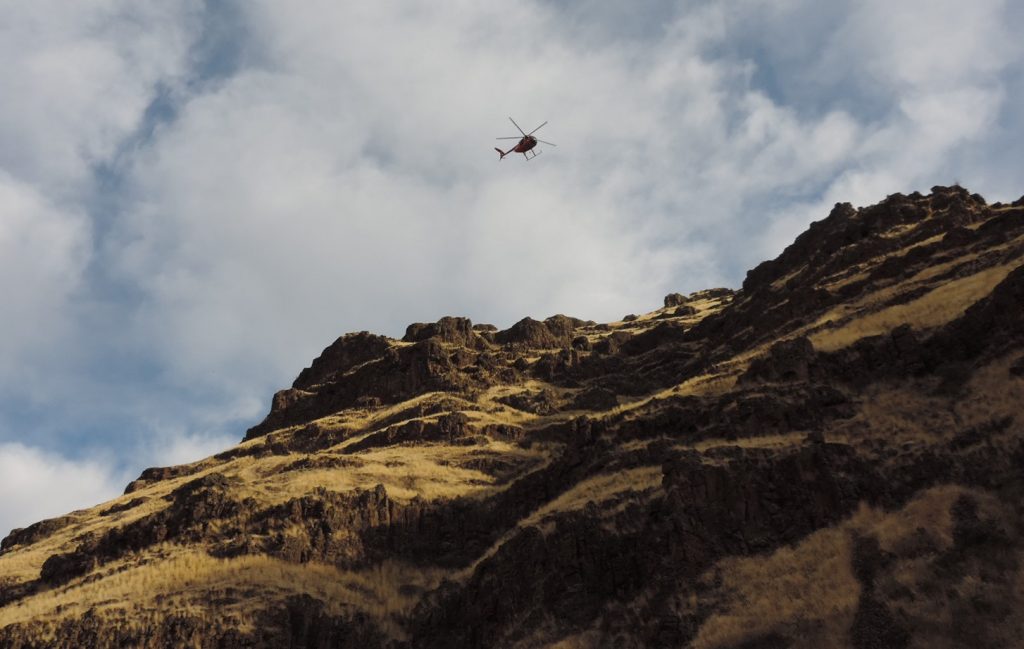Dozen Bighorns Removed From Quilomene Herd; Disease Test Results Due
A dozen bighorns including nine rams from a Central Washington herd were lethally removed by state wildlife officials Monday and disease testing results expected tomorrow will determine next steps in an effort to head off a potential disease outbreak caused by a wandering domestic sheep.
More information is also coming out about how the situation, first reported yesterday, came about.
According to WDFW, the ewe was first observed with seven Quilomene Herd rams on Sept. 26 at the mouth of Hole in the Wall Canyon, at the very northern edge of Gingko Petrified Forest State Park, by an off-duty sheriff’s deputy.

That information was passed along to a colleague in WDFW’s enforcement division, with the agency’s Wildlife Program becoming aware of it on Thursday, Oct. 1, according to Brock Hoenes, Ungulate Section manager.
He said staffers then “responded immediately.”
On Monday, Oct. 5, a boat searched along the Columbia’s west bank north of I-90 for the ewe, but came up empty, so the next day WDFW took to the air in a helicopter, located the animal and shot it, Hoenes said.

It wasn’t clear whether the entire sheep, its lungs or a nasal swab was then driven to a Washington State University lab, but he said a report came back that night that it had been carrying Mycoplasma, a bacteria that causes pneumonia in bighorns and is often fatal.
With the disease, wildlife managers have to act fast to keep it from spreading more widely among bighorn herds.
Hoenes said that given the location of the wild sheep and the state parks’ ban on shooting, WDFW needed a couple days to figure out logistics of a removal operation, as well as reach out to stakeholders including the Yakama Nation and Wild Sheep Foundation.
Yesterday WDFW returned to the area and killed six adult rams, three young rams and three ewes, according to Hoenes.
He said samples from the 12 sheep were sent to WSU and results had been expected today but a delivery delay will keep that from being known until tomorrow.
Officials were unable to salvage and donate the meat “because we did not have time to coordinate a plan for getting it off the mountain, processing it, and getting it delivered,” Hoenes said.

For now only the dozen were lethally removed, but next steps depend on what the test results are. Hoenes said if they’re all negative, WDFW might try some additional live captures for more testing.
If they’re positive, WDFW will have to sit down and talk about the path forward.
In 2009 and 2013, the agency had to eradicate dozens upon dozens of bighorns in the Umtanum and Tieton Herds to keep members from infecting nearby animals.
“It’s a frustrating challenge keeping pneumonia out of wild sheep populations,” Hoenes said.
Also frustrating: tracking down exactly where the ewe came from.
Where it turned up at – Hole in the Wall – is miles from private winter pastures, let alone land that domestic sheep would be grazing in late September.
Immediately to the east is the Columbia’s Wanapum Pool; to the north are rugged barren breaks that stretch to nearly Wenatchee; to the south is the tiny burg of Vantage perched on the western shore of the big river; and pinning Vantage in to the southwest, west and northwest is a vast expanse of WDFW, DNR and US Army lands that stretch to well west of Rye Grass Pass and the Ellensburg area.
Hoenes said that the operator only reported the one lost sheep, which was “known to have been missing since September 13.”
Earlier today a WDFW spokesman indicated it had been grazing on a Forest Service lease, but Hoenes backed away from that.
“We don’t know where it could have come from,” Hoenes said.
The ewe’s owner has grazing permits in multiple ranger districts of the Okanogan Wenatchee National Forest, as well as with DNR.
In Kittitas County, those lands are on either side Highway 97 on the southern leg of Blewett Pass. It wasn’t immediately clear when DNR grazing leases run through, but the Forest Service’s Swauk allotment needed to be vacated by Sept. 11 this year.
Those summer pastures are quite a distance from Hole in the Wall – through a wolf pack’s territory and over the Colockum – though the ewe could theoretically have also escaped from a closer winter pasture after its flock was brought off the allotment for the season.
“When these sheep go on walkabouts, they can go vast distances,” Hoenes observed.
How far it wandered and for how long it was loose will help determine exposure risk to one of the state’s strongest herds of bighorns. Living on the cliffs and gulches along the arid mid-Columbia, it also had one of the lowest annual probabilities of contact by domestic herds grazing in Central Washington.
That’s according to a February 2016 risk assessment done for the Okanogan-Wenatchee National Forest about the potential impact livestock on federal grazing leases could have on bighorns, and which stated the Quilomene herd “would not be expected to experience a disease outbreak within 50 years.”
Hopefully that holds true and test results from WSU show that no Quilomene bighorns were infected by the ewe, but it’s 2020 so it’s hard to not expect the worst or that there won’t be more twists in this story.
